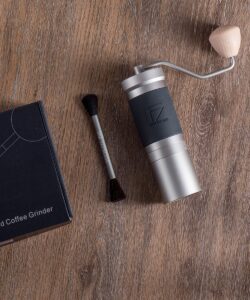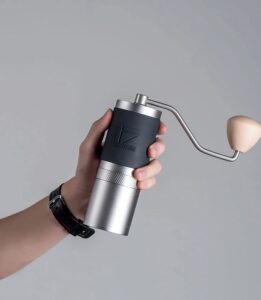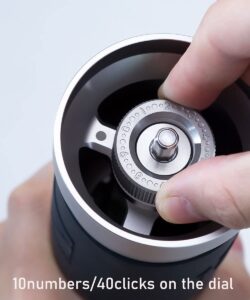Last Updated on 19/08/2023 by Miki
Table of contents
A coffee enthusiast will spend what feels like hours browsing the web for the perfect coffee grinder. For your optimal cup of coffee, I highly recommend using a coffee grinder, especially a manual one. Why? Well, it’s because you can control the coarseness or fineness of your coffee beans, which is crucial to a perfect cup. I’m pretty sure that you have come across “1Zpresso JX” and “1Zpresso JX-Pro” while searching for your perfect coffee grinder. You might be wondering if the JX-Pro would be better or what’s the difference between the two. I would like to share my ultimate comparison of the JX vs JX-Pro here in this article.
Personally, 1Zpresso JX-Pro is my top pick of the best manual grinders on the market. It’s a popular choice for coffee enthusiasts and connoisseurs alike. It comes with stainless steel conical burrs and easily adjusts from fine to coarse grinds. What’s more, its elegant stainless steel design makes it a winner when setting up your kitchen bench. Having said that, JX can be the one for you if you are after a more budget-friendly option or prefer manual brewing. By comparing the JX vs JX-Pro, I’m hoping that you will be able to choose the one for you.

This post may contain affiliate links. If you use these links to purchase something, I may earn a commission without any extra cost to you. I would appreciate it if you do so to keep this blog going!
1Zpresso JX vs JX-Pro – Design
Both the JX and JX-Pro are new and innovative manual grinders. With their sleek and sophisticated design, they can make you feel good in the kitchen. They are also made with the user in mind.
With their simplistic cutting-edge design, they are both easy to use and easy to clean. The conical burr is made of stainless steel, which is stain-resistant and also rust-resistant. In addition, the self-contained design means that the ground coffee stays in the receiver for your convenience. What’s more, the JX and JX-Pro don’t have any hidden compartments making them easy to clean. Overall, they are not only beautifully designed but also functionally designed. We will take a look at more comparisons next, so stay with me!

1Zpresso JX vs JX-Pro – Size & Portability
We are always looking for ways to save space, and when it comes to coffee grinders, both 1Zpresso JX and JX-Pro may be just what we are looking for. Both manual grinders are designed for those who have little counter space. If you have a small kitchen that is short on counter space, then these coffee grinders might be just what you need to get brewing your cups. The JX is slightly lighter with 700g in weight whereas the JX-Pro weighs 780g. Both grinders have the capacity of 30-35g of ground coffee. The big question here is “Are these grinders portable?”
Well, I wouldn’t say they are portable due to their weight. I don’t want to carry my bag with 700-780g extra for work every day. As a typical lady, my bag is already heavy enough! With that being said, they may be great for travel if you drive or stay somewhere for a while. Ultimately, you deserve to have a decent cup of coffee no matter where you are.
1Zpresso JX vs JX-Pro – Grind Consistency
Both the JX and JX-Pro feature a 48mm conical burr, so there is no surprise that the consistency is similarly amazing. Those grinders can grind your coffee not only efficiently but also consistently. You will be impressed by how few fines they produce. The fines can cause your filter to clog, so you will notice how fast you can make pour-over coffee with the JX and JX-Pro alike. Ground beans need to be uniform if you would like to brew your perfect cup of coffee. Therefore, those manual grinders won’t disappoint you in terms of grind consistency.
Grinding Adjustment for JX-Pro
How does coffee grinding adjustment work? 1Zpresso JX-Pro manual coffee grinder is adjusted with the dial on top of the machine and allows the user to choose the desired grind size. You don’t need to disassemble to adjust the grinding, so it’s a plus for its convenience. There are 10 numbers on the dial from “0” to “9” and they are for counting the number of steps you turn the dial. It means that “0” doesn’t necessarily mean the starting point. Therefore, you will want to calibrate the grinder if you want “0” as the zero setting. Then, how can you find that point? The good news is that it’s quite easy! Simply turn the dial clockwise till you feel the resistance in the movement. You will know when the grinder handle stops moving remarkably. That’s the zero settings.

The size of coffee grounds is on a continuum from espresso to French press. You will need to turn the dial clockwise to produce finer grinds by tightening it, and for coarser grinds, you simply do it counter-clockwise by loosening it. There are 10 numbers and 40 clicks in a full rotation, which equals 4 clicks per number. What exactly does it mean? Well, here is your reference:
- Turkish – turn the dial counter-clockwise for 8 numbers (0.8 rotation/32 clicks)
- Espresso – turn the dial counter-clockwise for 1 full rotation (10 numbers) & 5 numbers (total of 1.5 rotation/60 clicks)
- Aeropress/Moka-Pot/Drip Coffee Maker – turn the dial counter-clockwise for 2 full rotations (20 numbers) & 8 numbers (total of 2.8 rotations/112 clicks)
- Siphon/Pour-Over – turn the dial counter-clockwise for 3 full rotations (30 numbers) & 6 numbers (total of 3.6 rotations/144 clicks)
- French Press – turn the dial counter-clockwise for 4 full rotations (40 numbers) & 8 numbers (total of 4.8 rotations/192 clicks)
You may be wondering what these clicks do. The answer is each click shifts the burr by 0.0125mm. How precise it is! You can experiment with the grind setting according to your brewing method and preferred coffee beans 🙂
Grinding Adjustment for JX
On the other hand, 1Zpersso JX is designed for internal adjustment that requires disassembling to change the grinding. There are 10 numbers on the dial same as the JX-Pro. However, the JX has 30 clicks per full rotation and each click shifts the burr by 0.025mm, which makes this grinder less precise than the JX-Pro. Having said that, it’s still great in doing its job. Here is your reference:
- Turkish – turn the dial counter-clockwise for 5 numbers (0.5 rotation/15 clicks)
- Espresso – turn the dial counter-clockwise for 7 numbers (0.7 rotation/21 clicks)
- Aeropress/Moka-Pot/Drip Coffee Maker – turn the dial counter-clockwise for 1 full rotation (10 numbers/30 clicks)
- Siphon/Pour-Over – turn the dial counter-clockwise for 1 full rotation (10 numbers) & 4 numbers (total of 1.4 rotation/42 clicks)
- French Press – turn the dial counter-clockwise for 2 full rotations (20 numbers) & 5 numbers (total of 2.5 rotations/75 clicks)
I would recommend JX for producing coarser grinds due to its limit of clicks.
1Zpresso JX vs JX-Pro – Grinding Speed
Both the JX and JX-Pro are manual grinders, so obviously you will need to grind your coffee beans by hand. One of the points to consider in choosing a manual grinder is the grinding speed. This is especially true if you don’t have much time in preparing your coffee in the morning. With the JX, you can grind 18 grams dose of pour-over in about 25-30 seconds. Ever the same dose of espresso takes only about 50-55 seconds. You will have freshly ground coffee within 1 minute!
We tend to think the “Pro” version would be faster in grinding coffee beans. However, to my surprise, the JX-Pro is slower than the JX although they are both one of the fastest manual grinders on the market without a doubt.
How To Calibrate – JX vs JX-Pro
There are many ways that you can make sure your coffee tastes the best it can be, and calibrating your grinder is one of the most important ways. Why? It’s because you should be able to adjust grind settings according to your desired size and it makes your life easier if you calibrate your grinder first. Since the adjustment types are different between the JX and JX-Pro, the ways to calibrate differ as well. Here are the guides:
For JX with its internal adjustment, it’s extremely simple. All you need to do is turn the dial clockwise till the handle stops rotating significantly. Then, you’ve got the starting point! Be aware that the “0” on the dial doesn’t necessarily mean the starting point as the numbers are for counting how many times you turn.
For JX-Pro with its top adjustment, the same concept as the JX applies. However, there is a difference. You can set the “0” on the dial as the starting point. This would surely make your grinding easier. You can simply follow the steps below.
- If you see the dot is pointing to “2” for instance when the dial is firmly tightened, then you need to remove the dial by twisting it counter-clockwise.
- Turn the knurled thumb nut counter-clockwise with 2 clicks.
- Put the dial back and tighten it. The “0” should be the starting point now. If not, repeat step 2 by experimenting with 1 or 2 more clicks.
- Note: At the beginning, if the dot is pointing to “3”, then you need to turn the knurled thumb nut with 3 clicks in step 2. Just make sure the same number for the click.
You are good to go now 🙂
How To Clean – JX vs JX-Pro
Cleaning your grinder might not sound like the most fun coffee-related task you can take on, but it will help keep your caffeine fix tasting better and more enjoyable. Moreover, good maintenance will make your grinder last longer. 1Zpresso recommends disassembling the grinders monthly to perform cleaning and maintenance. The good news is you can disassemble them without any special tool. Now with just a few simple steps and a handful of materials, you can have your grinder in tip-top shape and ready for the next brewing session.

The steps for JX:
- Grab the top of the grinder with one hand and the bottom with the other hand. Turn the catch cup counterclockwise to remove it.
- Turn the adjustment dial counter-clockwise till completely loosened to remove the burr set. You should be able to remove the dial and the bearing cap.
- After removing the burr set, attach the catch cup and turn it clockwise to remove the outer burr.
- Turn the lid counter-clockwise to take out as well as remove the wooden knob. You can clean all those parts with the cleaning brush that comes with the grinder. DO NOT wash them with water!
The steps for JX-Pro:
- Detach the handle and turn the adjustment dial counter-clockwise to remove it. Remove the catch cup as well.
- Press the burr from the bottom so that you can turn the knurled thumb nut counterclockwise to loosen it.
- Press down the central shaft to remove the burr set. Carefully take the sliding column out of the upper ring cap.
- Turn the upper ring cap clockwise to disassemble. Put the catch cup back and turn it clockwise to take out the outer burr ring.
- Turn the lid counter-clockwise to remove as well as detach the wooden knob. Clean all parts with the handy brush and air blower. Again, do not wash them with water.
Final Thoughts on JX vs JX-Pro
As you have seen here in this post, there are both similarities and differences between the JX and JX-Pro. And both manual grinders are superb! The big question for JX vs JX-Pro is “Which model is the ultimate winner?”
Well, it may sound ordinary, but it depends! If you are an espresso lover like me, then I would recommend the JX-Pro. It produces excellent grinds for espresso with its superior grind setting. On the other hand, if you usually use manual brewing like pour-over or French press, then the JX will do an excellent job and you will be satisfied with the coffee it makes. There are some other pros in the JX like weight and speed. Comparing all the pros and cons, I hope this article has been helpful to choose the best one for you.

This was helpful, thanks. As I make exclusively pour-over, I will get a JX.
I’ve had two Hario’s (incl Skerton Pro) which just don’t cut it. I have a Timemore which is excellent, but I need somethign a touch larger than what the Timemore can fit for multiple cups at home.
Thank you for your comment, Troy.
I’ve had a Hario as well, but it’s not easy to produce the perfect grind for my espresso machine.
A JX is much more reliable in my opinion 🙂